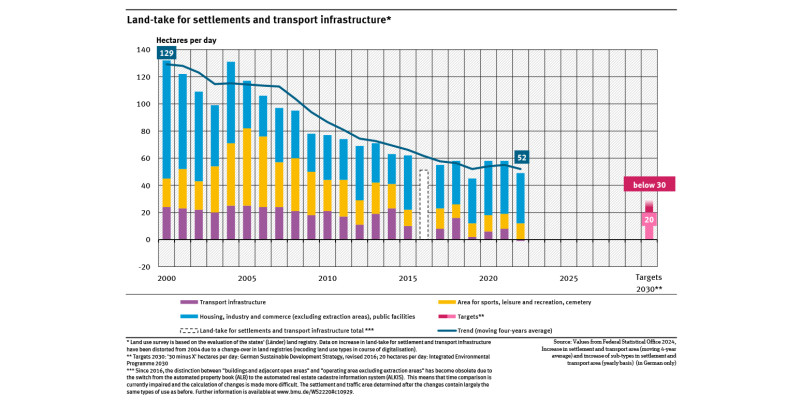Indicator: Land-take for settlements and transport infrastructure
 Click to enlarge
Click to enlargeSource: Federal Statistical Office of Germany Figure as PDF
 Umweltbundesamt
Umweltbundesamt
 Click to enlarge
Click to enlarge
- Between 2019 and 2022, 52 hectares of land per day were newly dedicated to settlements and transport infrastructure.
- Originally, the increase was to fall to 30 hectares per day by 2020. According to the goals of the sustainability strategy, the daily increase now should be less than 30 hectares per day by 2030.
- The Integrated Environmental Programme of the Federal Environment Ministry specifies a reduction in the daily increase to 20 hectares per day by 2030.
- Additional actions are necessary in order to achieve these targets.
The conversion of agricultural land, forests or grassland to settlements and transport infrastructure has significant environmental impacts. Much of the land is covered with buildings and other facilities or sealed to expand transport networks. This destroys the natural fertility of soils, thereby impeding future (re-)use for agriculture and forestry. Sealed surfaces (i.e. asphalted or paved) lose their ability to regulate the microclimate and are unable to mitigate the overheating of towns and cities in summer. In addition, the loss of these areas has an adverse effect on species diversity as the new settlements and transport infrastructure increase fragmentation of landscapes and reduce the size of habitats.
Furthermore, newly developed settlements and transport infrastructure generate additional traffic which in turn creates noise and pollution. Material consumption also increases for the construction of buildings and development infrastructure. New buildings and infrastructures have to be operated, thereby energy consumption increases as well.
The EU's 'Roadmap for a Resource Efficient Europe' aims to reduce land use in such a way that by 2050 no more land is consumed in net terms (COM/2011/0571). The objectives of the sustainability strategy (BReg 2016) and the climate action programme 2030 (BReg 2019) specify that by 2030 less than 30 hectares per day should be newly designated as land for settlement and transport purposes. The 'Integrated Environmental Programme 2030' of the Federal Environment Ministry mentions a more ambitious target of 20 hectares per day for the year 2030 (BMUB 2016), as this figure should be achieved if a linear progress towards the net zero target for 2050 is made - as also intended in the 'Climate Action Plan 2050'.
Between 2019 and 2022, the settlement and transport area increased by an average of 52 hectares per day. Since 2000, the daily increase in settlement and transport area has been roughly halved. The reasons for this were stricter regulations in building and planning law, greater efforts in the federal states and municipalities, subdued economic development and demographic change. These last few years, the trend has stagnated. Still, the target of the Integrated Environmental Programme of 20 hectares per day by 2030 can be achieved. However, maintaining the trend is challenging, as the slight increase in 2020 shows.
The indicator shows the average increase in settlement and transport area in hectares per day. Settlement and transport areas include areas for housing, industry and commerce (excluding mining land), for public buildings, areas for sports, leisure and recreation (incl. cemetery areas) and traffic areas. The indicator is calculated annually by the Federal Statistical Office on the basis of the land use data reported by the Länder. In many cases these are subject to special effects and must be partially corrected by the Federal Statistical Office. Further information on this can be found in the ‘Explanatory notes on the indicator Increase in settlement and transport area’ (in German only).
More detailed information: 'Siedlungs- und Verkehrsfläche' (in German only).